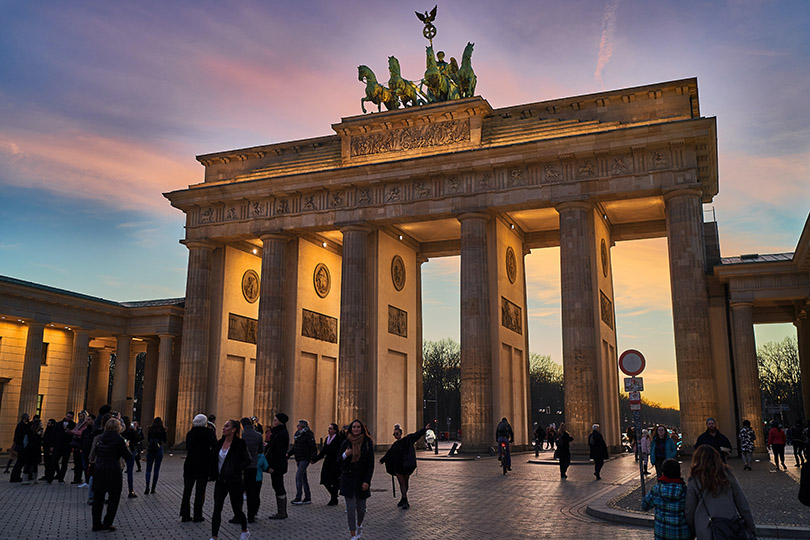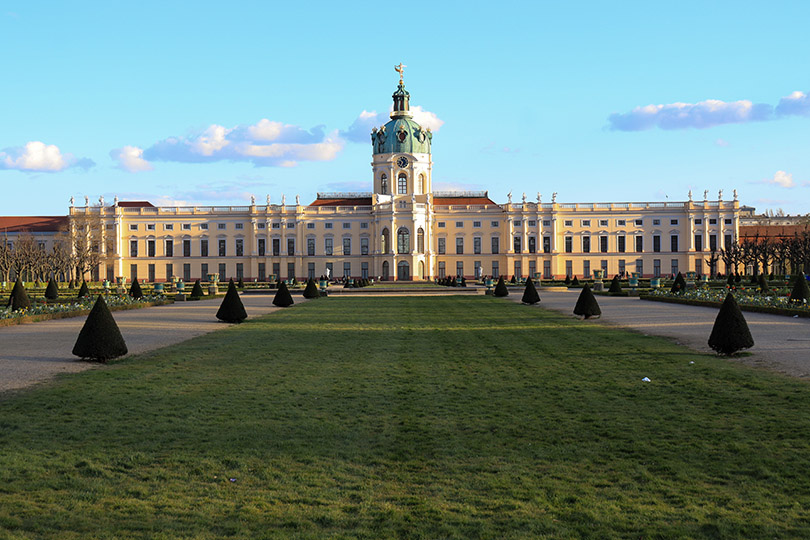
Brandenburg Gate, Berlin
Berlin History
Few cities in the world can boast of as many radical transformations over their history as Berlin. They have produced many historic sites and tourist attractions today. Here is a chronological listing of highlights that help you appreciate those historic sites and tourist attractions:
In 1230, St. Nicholas church was built in Nicholas District.
In 1237 AD, the official founding of Berlin was first recorded. By 1280, Berlin was given a town seal depicting two bears.
In 1356, Mark Brandenburg becomes an Electorate. Shortly afterward, Berlin developed wide-ranging trade relations, and its economy blossomed as a medieval trading center. In 1432, Berlin and Cölln merge to form a single city.
In 1432, Berlin and Cölln merge to form a single municipality. The elector Friedrich II puts an end to this joint administration in 1442 in the interest of expanding his own powers.
In 1486, The elector Johann Cicero makes the palace in Cölln the permanent residence of the Brandenburg electors of the Hohenzollerns. Becoming the seat of the ruler boosts the city’s political significance, but also entails a loss of its freedoms.
In 1658, Berlin and Cölln are built up to create a fortress in the form of a star with 13 bastions. Remains of these fortifications can still be seen near the Märkisches Museum.
In 1671, Berlin’s Jewish community is founded. By 1700 it has grown to a total of more than a thousand people and 114 families.
In 1672, the Huguenot community is founded with an initial 100 members.
In 1685, Friedrich Wilhelm, issued the Edict of Potsdam. Many of the Huguenots being persecuted in France for their faith moved to Berlin and Mark Brandenburg.
In 1695, Friedrich III has a palace built for his wife, Sophie Charlotte, west of Berlin/Cölln near Lietzenburg. After her death in 1705, it is renamed Charlottenburg Palace.
In 1701, the elector Friedrich III had himself crowned Friedrich I, King in Prussia. Berlin becomes the royal residence.
In 1709, King Friedrich I decrees the unification of the five towns of Berlin, Cölln, Friedrichswerder, Dorotheenstadt, and Friedrichstadt to form the capital and royal residence of Berlin. The unified city has a population of 55,000.
In 1717, Compulsory school attendance is introduced in Berlin, although it takes several decades for it to become established.
In 1740, Berlin develops into a center of the Enlightenment and of constant construction under Friedrich the Great. The large buildings in this era still dominate the cityscape.
In 1770, the bridle path from the City Palace to Tiergarten that was laid out in 1647 is expanded into a magnificent avenue. By 1791, Brandenburg Gate officially opened.
In 1805, the cattle market and parade ground just outside the city wall is named Alexanderplatz in honor of the Russian czar Alexander I, who visits Berlin in October 1805.
In 1806, Napoleon and his troops march through Brandenburg Gate into Berlin. The French rule Prussia (now Germany) until 1814.
In 1809, Baron von Stein grants Berlin wide powers of self-government. Elected for the first time, a city assembly puts forward a mayoral candidate to be approved by the king.
In 1810, Berlin’s first university, Humboldt University, opens in the Prince Heinrich Palace on Unter den Linden. Johann Gottlieb Fichte becomes its first president.
In 1816, the continent’s first steam locomotive is manufactured in the royal iron foundry established in 1804 on the Panke river.
In 1830, Altes Museum (Old Museum) opens at the Spree island in the first Prussian building designed to be a museum.
In 1838, Potsdam and Berlin are connected by Prussia’s first railroad line.
In 1844, the Zoologischer Garten is opened on the edge of the Tiergarten park as Germany’s first zoo.
In 1869, the new Berlin Town Hall, still in use today, is completed and, because of its red-brick construction, quickly dubbed the “Red Town Hall.”
In 1871, Berlin becomes the capital of the German Reich. This boost in political status, industrialization, and the economic boom of the next few decades give rise to many new businesses in the city. Berlin becomes the empire’s political, economic, and scientific capital.
By 1877, the population grew to more than a million.
In 1878, legislation outlawing the organizations, publications, and meetings of Social Democrats, viewed as “enemies of the German Reich,” is introduced and not repealed until 1890.
In 1879, Siemens & Halske presented the world’s first electric railway at the Berlin Industrial Exhibition. In 1881, the world’s first electric streetcar is introduced in Germany.
In 1882, Kurfürstendamm avenue was modeled on the Champs-Elyseés in Paris. It drew prominent residents and cultural attractions. The road connecting the city with the royal hunting lodge in Grunewald is revamped to form a magnificent boulevard, Kurfürstendamm, modeled on the Champs-Elyseés in Paris and extending to Halensee.
In 1892, Neues Theater opens.
In 1902, Berlin’s first U-Bahn (underground railway) line goes into operation.
In 1911/1912, Berlin joins with Charlottenburg, Schöneberg, Wilmersdorf, Lichtenberg, Spandau, Niederbarnim, and Teltow districts to form Greater Berlin.

Charlottenburg Palace, Berlin; credit Goke Obasa
In 1912, Berlin population passes 2 million.
Over 1914-1918, the First World War ends on November 11 with an armistice, after Kaiser Wilhelm II is ousted and flees into exile in the Netherlands. The Social Democratic politician Philipp Scheidemann proclaims the “Free German Republic” from a window of the Reichstag on 9 November 1918. The Social Democrat Friedrich Ebert becomes chancellor. Next month, Karl Liebknecht, Rosa Luxemburg, and Wilhelm Pieck found the German Communist Party (KPD) in Berlin.
In 1919, the Spartacist uprising is crushed in Berlin with Karl Liebknecht and Rosa Luxemburg murdered in the Tiergarten by Freikorps troops. Berlin was in ruins. During the Weimar era, Berlin underwent political unrest due to economic uncertainties, but also became a launchpad of the Roaring Twenties.
In 1920, parts of the military organizations attempt to stage a coup in response to orders that they disband, a requirement of the Treaty of Versailles. They declare the overthrow of the elected government and proclaim the right-wing politician Wolfgang Kapp the new chancellor. Berlin had become a fertile ground for the German Expressionist Movement in architecture, painting, and cinema.
In 1921, the world’s first highway is officially opened, the Autobahn. Albert Einstein was awarded the Nobel Prize for Physics.
In 1923, Inflation peaked. The incredible price of food & goods fed into public unrest.
In 1925, Berlin population passed 4 million.
In 1928, Television is introduced to Berlin.
In 1929, Germany is hit by the Great Depression like America. Berlin sees massive business bankruptcy spiked unemployment. Violent unrest follows.
In 1932, Berlin unemployment climbs to 630,000 nearly a third of adults in the city. Violent clashes between left-wing and right-wing groups leave many people dead or injured. These conditions became fertile ground the rise of the German Fascist Party led by Adolf Hitler.
